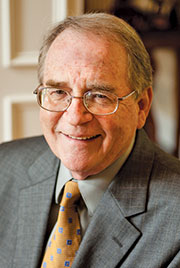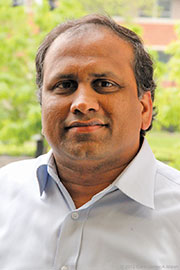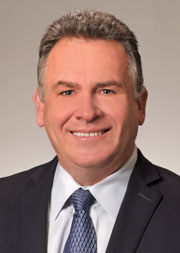The Conn Center is a research center hub at University of Louisville dedicated to renewable energy. Founded in January 2009, its mission is to accelerate and commercialize discovery in a suite of technologies that transform global energy challenges.
Hank Conn is a best-selling business author (“Workplace 2000”) and management consultant whose $20-million contribution (with his wife Becky) launched the Conn Center. The 2009 University of Louisville alumnus of the year, he maintains an active board presence and provides guidance to various multinational corporations, in addition to helping shape the center’s progress and vision.
Mahendra Sunkara, PhD (from Case Western Reserve University in Cleveland, Ohio), leads the Conn Center and is an accomplished scientist and chemical engineering professor who, over his 20-plus-year research career has been focused in advanced energy materials. His body of work includes semiconductor materials and their use in solar fuels/cells, power devices and capacitors.
Von Hatley, managing director, Jones Walker Consulting, recently visited the Conn Center and interviewed both men. The following are excerpts from their conversations. For the full conversation, see the July issue of The Site Selection Energy Report e-newsletter at siteselection.com.
VH:
Hank, what were you initially trying to accomplish by making the donation to the University of Louisville?
HC: Our global energy needs are great, and are exponentially increasing. When you look at our future, we’re going to continue to face increasing prices at the gas pump, global climate change and billions of people that will not have access to any electrical grid. As my wife Becky and I discussed this, we asked ourselves “Rather than waiting, what can we do now that can help these challenges?” Having receiving my engineering degrees from the J.B. Speed School of Engineering in the 1960s and ’70s, I knew that, given the leadership at the university and throughout the state, they had all of the right building blocks to help us make a difference. This is where I felt I could not only personally provide the impetus for the necessary advances but also to put constant focus on the challenges at hand to provide a platform for creating real and long-lasting value for the global community.

“The center and its staff have helped us enable our vision for a
45-acre research park happening now, which actually beat my vision of a groundbreaking within 10 years.”
– Hank Conn
The Kentucky legislature created the idea of a center on renewable energy and environmental stewardship in 2007. We worked with the legislature and the university to develop and implement the center through an MOU in 2009 as a direct result of our financial commitment. This was the largest gift ever from individuals in state history, which made my wife Becky and I the poster children for doing something right in Kentucky as individuals. We then set up a plan with University President James Ramsey to establish the center. Through interactions with him and his team, plus members of our Industrial Board of Advisors, we’ve been able to steer the involvement of large corporations to work in collaboration with the school and center.
VH:
What has been the progress to date with the center? In particular, how did you attract talent?
HC: We made a number of trips to U of L to scout for talent to see what type of research may already be going on that can serve our mission. We met Mahendra, and recognized his existing talent, passion and success to date. We were enlightened that he was already focused on fundamental advances in materials, which are essential from a technical aspect. We groomed him to lead and build a team attracting experts from relevant industry and academic institutions, and develop the R&D themes. The center and its staff have helped us enable our vision for a 45-acre research park happening now, which actually beat my vision of a groundbreaking within 10 years. The potential to attract and retain industry from multiple sectors lies in our ability to innovate at pre-commercial scale. We will be able to champion for product realization utilizing a vast array of technologies.
VH:
Mahendra, describe how the Conn Center is working with private companies in Kentucky and around the globe on projects that may result in job-creating manufacturing or R&D operations.

“Renewables
will start to play a more important role in distributed generation both in developed and under-developed regions while slowly ramping towards providing baseline load at larger scale with innovations in storage.”
– Mahendra Sunkara
MS: What we’re doing is creating a micro factory environment in which to create and define products that integrate various energy devices, such as solar cells, lighting and energy storage, among many others. We’ve received great interest from industry leaders and from global conglomerates such as GE, which we’re helping to develop next-generation energy efficient appliances. This year the University will be building a research park including an ambitious Launchpad for new product realization with space in excess of 200,000 square feet [18,580 sq. m.], and we look forward to being an anchor tenant with them to enable the park to grow and prosper. A local example in Kentucky is Brown Forman, which we’re helping in utilizing industrial biomass (in particular, spent distillers grain) to create valuable chemicals. In this instance, we are able to take something that the bourbon industry had as a waste by-product (which cost them money to dispose of), and now they are able to sell this in order to create revenue for them, and lessen the environmental impact for all of us.
The companies that are showing interest range from energy materials manufacturing to power device manufacturing to energy technology startups. We’ve had interest from a silicon wafer reclaiming company in Louisville, and another example includes a materials manufacturer from China who wants to set up a production facility in Kentucky and wants to use Conn Center for R&D and testing. We also have several start-up companies that are utilizing our facilities as they seek and receive various funding streams from both the public and private sector.
VH:
Industries across many sectors are looking for ways to bring renewables on-site at different locations, and to become more energy-efficient in operations of various kinds. Where around the world do you see companies pushing the envelope in this regard?
MS: We see interest in many areas, but four of the primary geographical regions are areas with high electricity costs (especially ones that have inefficient generation capability and higher carbon footprints); current or impending low water availability; a high consciousness for carbon emissions and regulations; and little or no availability of power grid infrastructure.
These areas are literally located around the entire globe, but ones that initially come to mind are Western states such as California, Arizona and Nevada with high electricity/low water availability; Africa with low power grid infrastructure; and Western European countries such as Germany and the Scandinavians, who have been early adopters to green technology, and will continue to push the envelope towards a greener world.
VH:
The Conn Center was established with one goal of targeting federal research funds for renewables. Where do you see governments around the world providing the most forward-thinking support?
MS: The United States, in particular, has set up five research hubs and has a strong infrastructure in national labs, including one focused entirely on renewables. In addition, the current administration has provided a renewed interest in manufacturing recently. So, on the federal level we are seeing more investment in higher risk projects to get an even greater return from breakthrough technology as it relates to renewable energy.
In addition to the countries mentioned earlier, we are also seeing keen interest in Japan as a result of their recent nuclear power plant disaster. They really want to push the envelope for technology development in alternate technologies for power production.
We also continue to see high levels of support from Germany and the Scandinavian countries mentioned before, but really in the European Union as a whole as they further develop awareness, enact laws and promote lifestyles that support environmentally conscious behavior.
VH:
Are there certain things you are doing to keep the worldwide community engaged, focused and excited about the renewable energy research frontier?
MS: We established the Leigh Ann Conn prize for recognizing transformational advances in renewable energy research, which was recently awarded to Swiss Scientist Dr. Michael Graetzel. He’s created technology which, rather than using silicon for solar cells, uses iron, one of the world’s most abundant materials that also can be produced at a much lower cost. We are competing in various other challenges, such as the US DOE’s Solar Decathlon – our solar decathlon students last year received prizes and recognition in affordability.
VH:
According to current projections, electrical consumption will double by 2040, driven by demand from the US, China and India, and the predominant share of the fuel mix to generate this electricity will still be in coal, natural gas and nuclear, with hydro having somewhat of an impact. How do you think the center can impact this growing trend for the use of more fossil fuels and more towards renewables?
MS: We will see an increasing role for natural gas-led baseline generation for electricity to meet the growing demand. The natural gas resources will probably have the biggest impact on other fossils such as coal for generating electricity. Renewables will start to play a more important role in distributed generation both in developed and under-developed regions while slowly ramping towards providing baseline load at larger scale with innovations in storage. There will be great progress with the implementation of higher-efficiency solutions for energy use (such as high-efficiency lighting and power conversion) and associated devices. Technologies for converting waste heat into electricity could also have major implications. These technologies could meet about 40 percent of expected demand by 2040. No significant growth in hydropower is expected. However, renewable fuels could have a major impact on the use of fossil-derived oils. While natural gas has seen recent great attention, it may be temporary … around a decade or so.
VH:
Hank, we know of many R&D efforts, both domestically and abroad, that eventually fail either due to variation in funding streams, or general directional leadership changes. What steps are you taking to ensure the Conn Center will thrive well into the future?
HC: Well, the first thing is that we did provide a sound foundation for funding. In addition to my $20 million – which isn’t full yet – the university just completed a $1-billion capital campaign three months early, providing us a clear path to be a premier nationally recognized metropolitan research university, and we expect to have portions of that funding applied to the engineering school and Conn Center as well. We are able to attract the greatest minds, and build facilities that can be used well into the future, which is important, as we need to be positioned to succeed and to grow. This 45-acre park now under construction will allow us to do that.
Secondly, normal models look for a cash-positive return in a time frame that spans over a decade. Our mission is to be cash-flow-positive in three years at the research park. In order to do this, many of the standard measurements needed to change. Our theme leaders are focused on business goals, rather than just attaining tenure, and will be recognized and rewarded accordingly. The university approved a separate track for these individuals, for the first time ever. What this also allows us to do is to not simply rely on funding from state or federal sources. Certainly we seek and want to receive funding from these sources, but it can’t be our “fool’s gold.”
What this also means is that when products are commercialized, the university is willing to share in the benefits from commercialization commensurate with the effort of the partners, not only with the companies themselves, but even with the university staff and students involved in the research.
Lastly, you have to have the right mix. While having a few key anchor tenants is fundamental (quite frankly, some centers fail, and need to fail, because they don’t even get this right), you must also have small startups that are allowed to work in the same areas as the anchors, but work on major transformative research.
Having this alone (money and companies) still isn’t enough – you also still have to have great leadership at the university level who are supported by corporate board leaders, and then utilize federal and state governments when their funding and priorities ebb and flow over time to support your mission. Once all of these are in place, it provides the solid foundation for long-term success and prosperity.
VH:
You have had some great initial partners. If we were to fast forward five years, what other types of companies do you think will be involved at the Conn Center? Will they all need to be co-located in order to receive benefit?

Von Hatley, managing director, Jones Walker Consulting
HC: We have worked very hard at attracting private sector companies by making sure that our research were attuned to solving their problems or providing growth opportunities in their portfolios of products. A recent example was GE’s decision to locate their first global Micro-Factory on our Belknap Campus. We provided them with a beta site initially, and then they will move it to the research park when construction is completed. This announcement has sparked huge interest from other global companies to be a part of this “innovation beehive” at the research park. I think we will be fully subscribed with private-sector partners before we finish construction, but we have to be careful to have a blend of large, medium and small companies to make it the hub we dream about. Also, we must always have and maintain space for start-up companies to incubate from Conn Center energy research.
My view is that in five years we will need another 45 acres. However, co-location is not a requirement. We are in the midst of developing a partnership with a company that produces biomass fuel that performs like coal after densification. It has the same thermal content, handling and economics without the emissions problems. They have a pilot plant constructed in another state, and our role will be to provide expertise to fix some roll-out problems in their continuous process to attain the kind of volume to be a major player with power plants globally. The key is the densification process.
